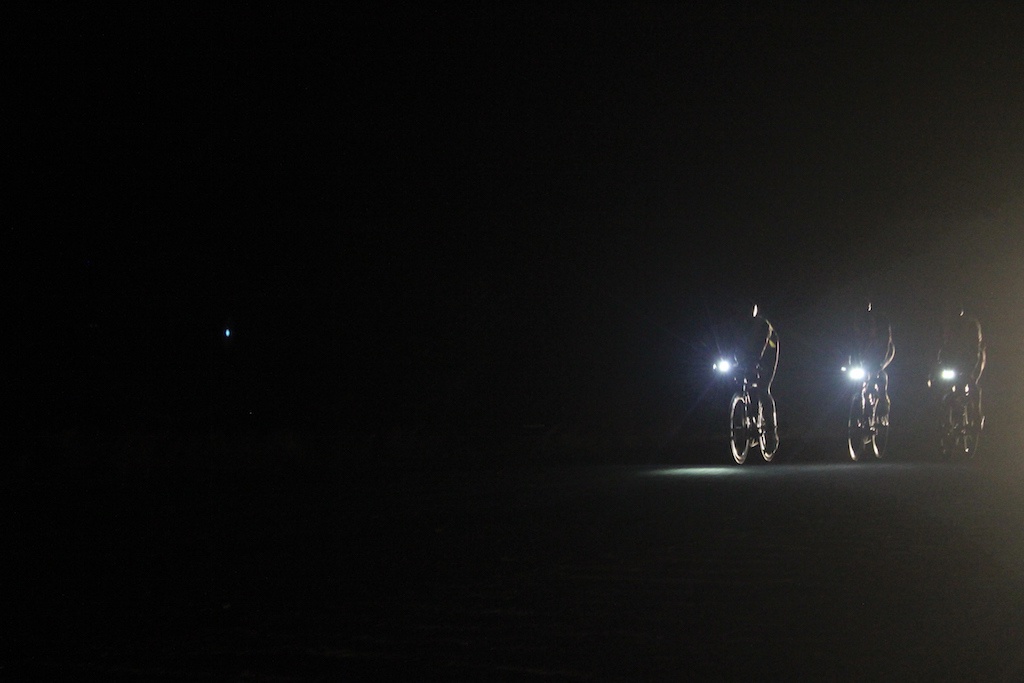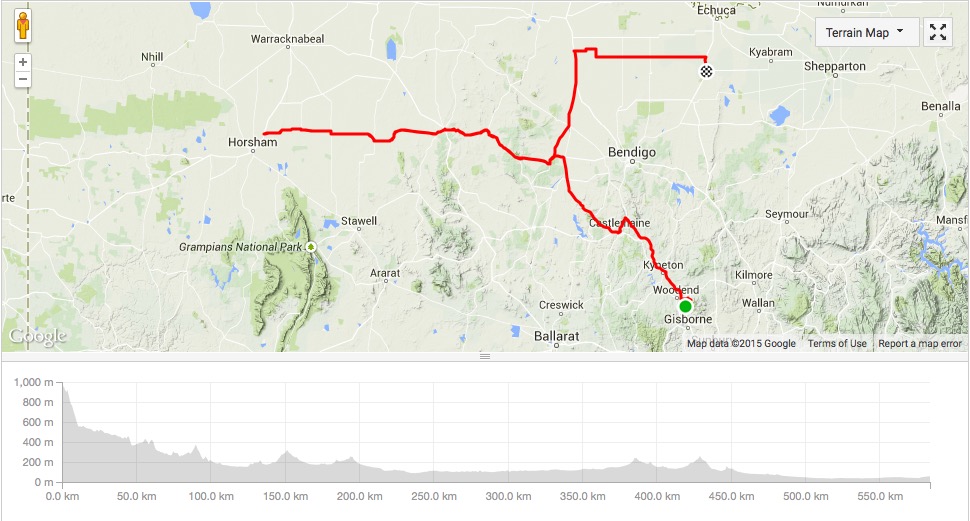Last weekend, Cycling Tips history writer Craig Fry and four friends attempted to break the Audax Australia Flèche Opperman 24hr Team Time Trial record and the World Record at nearly 800 kilometers. What is “The Oppy”? It’s a team time trial in which teams ride a route of their own choosing to a designated finishing point. In this piece he describes Team Pane e Acqua’s journey, the challenges they encountered, and what happened in the end.
Picture This:
Imagine you’ve entered a 24-hour, five-member team time trial on the open roads. You’re trying to beat the current Australian record (770km), and hopefully also the World record (778km) for this type of event.
The event rules state you have to finish with at least three riders. You can’t go around the same circuit again and again. It is not a relay.
And you can only get food, mechanical and other support at specific stop points that must be named on your course and submitted to event organisers two weeks before race day. No calling a support car for a wheel or bike swap on the go.
Now, also imagine being chased by another team of five riders (also attempting the record) which includes a three time Olympic and five time World rowing Champion Drew Ginn, and some other elite level riders for good measure.
Add to that scenario:
- Fierce westerly headwinds for the first 290km
- Your first team member pulling out with severe foot pain / neuroma at around 240km
- Losing another rider at around 450km to nausea and vomiting
- Rider number three reaching complete exhaustion at 584km, and falling off his bike unable to stand up let alone pedal
That was Team Pane e Acqua’s 2015 Flèche Opperman All Day Trial, and what a trial it was. We failed to achieve our goal. And that other team with the rowing champion was not imaginary – in fact Team Brevet achieved the very real result of getting three of their riders to 701km (Drew Ginn, Glenn Landers, Glen O’Rourke), losing just two riders along the way (Alistair Tubb, Scott Thomas).
Our Journey
These are the bare facts. But they do not tell the whole story. And these snippets alone perhaps give a misleading impression about the experience.
After having won the national Oppy Shield last year with 730km (also the longest in any 2014 24hr ‘flèche’ event like this internationally), Team Pane e Acqua 2.0 was keen to load up again for an attempt on the current Australian record (770km).
I won’t go over the planning, preparation and training we did in the lead up to #Oppy2015. You can get a sense of what’s involved in the piece I wrote about our 2014 attempt here, or see the training kilometers we racked up prior to the 2015 event here on Strava.
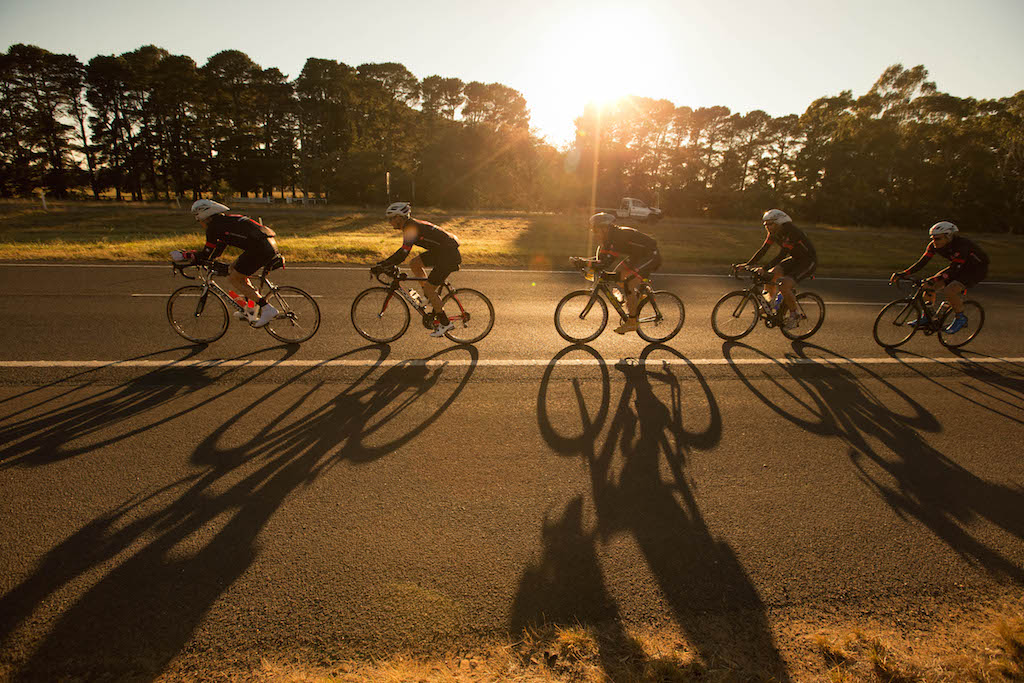
Suffice to say we took the 2015 challenge very seriously. And the news of another team attempting the record this year was good additional motivation, if not a little daunting considering their line up.
But the Flèche Opperman is not really a race against other teams. Regardless of the distance or number of hours you’re aiming for, you compete against just three things really: the weather; your mind; and your body.
All three factors eventually come into play for Oppy riders each year. Success or otherwise, no matter how you measure it, depends on how you handle the tough moments when they visit you.
So Oppy 2015 soon rolled around for us, and at 8:00am on Saturday 14 March we began our 24hrs on top of Mount Macedon in Victoria – the site of the 21-metre high memorial cross to honour all who have served in wars and conflicts.
We thought it was a fitting tribute to Sir Hubert Opperman’s wartime service. His cycling career ended with World War II when he joined the RAAF, serving from 1940 to 1945. He raced briefly after the war but retired in 1947.
Mt Macedon also provided a great way to start our 24 hours at pace, and get some early momentum on what we knew would be a tough day.
Downs, Ups, Downs
Our first section to Maldon went well and was fast – 89km at 38kph. At this first stop some of us changed to time-trial bikes to counter the head-wind we knew was coming.
And come at us it did. Our next 200km through Newbridge – St Arnaud – Marnoo – Rupanyup – Murtoa to our turnaround point outside of Horsham was tough. My heart rate was higher than it should have been, and I could only pull short turns before sliding to the back to rest.
This was made possible largely through the efforts of Mat Tippett, Marty Fluker, and Team Captain Chris Munro - all pulling big turns on the front into the wind.
Chris’s on-road leadership in particular was crucial (calling wind directions and rider positions, and giving frequent words of encouragement to all). And his role in getting the team together in the first place, organising training rides, and a multitude of other details was critical too.
As an ex-elite level triathlete (representing Australia in 1998 and 2000 at the Triathlon World Championships) Chris is an amazing athlete. This guy even at 44 has a VO2max of >70, and is without doubt the strongest rider in our group. His preparation for the Oppy2015 included the Alpine 320 in around 12.5hrs, and the week following an 1100km training block Chris Everested Mt Benwerrin in Lorne (21 ascents over 430km for nearly 9000m of climbing in just under 19hrs).
For those tough first 290km we were all glad to have Chris in our team.
We managed to hold an average speed of 30kph over that distance into the wind, but this effort exacted a hefty toll. At the 290km turn around point we were 21 minutes behind schedule, and we had lost our first rider (Tom Ainsworth) at around 240km.
Tom (the son of former Geelong Football Club Captain Geoff Ainsworth) had come into the race with severe neuromas in his feet. He had had treatment and was resting his feet two weeks before the event (keeping fitness up by rowing, deep water running, swimming and core work), but in the wind and heat they flared up again and Tom simply couldn’t continue.
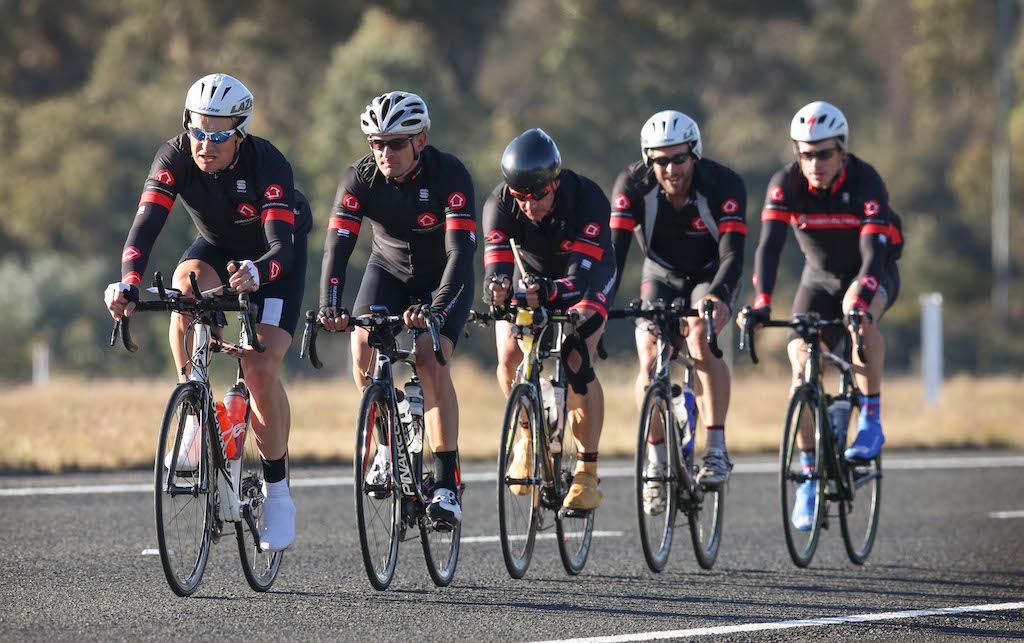
One minute he was there with us, and the next he was gone. I looked back to see him getting in the van. Its pretty confronting when you start losing riders, and that moment brought an unwelcome voice of doubt into my head: “You’re next Craig…in the van. You’re struggling too. It’d be easier to stop.”
So then the mental battle begins: “Just one more turn for the boys. 5km more or 3km even. Just get to the Horsham turn around for that tail wind. Ignore your heart rate. It’s just a number. You’re strong. Done this before. One more turn for the team.”
Small things matter
As this was going on we approached our next scheduled stop (at 254km in Rupanyup), and there’s Tom out of the van striding down the roadside barefoot, clapping and cheering and yelling for us louder than anyone.
Small things matter on a ride like this. Only, it wasn’t a small gesture on Tom’s part. He would have been devastated to pull out, and could have been forgiven for taking some time for himself in the van. But no, instead he went straight into support mode: attentive; positive, and there for us.
After seeing Tom do that I didn’t hear my negative voice again. Courageous and inspirational efforts can come from moments of defeat too. What an awesome display from him.
Things improved for us from there as we turned east and the strong wind was now behind us. Enemy becomes friend.
We covered the next 98km section through to St Arnaud (388km into our ride) at 40kph which meant we were now back 15 minutes in front of schedule (i.e. a 36 minute turn around). Happy days!
Our support crew had ordered pizzas that were hot and waiting for us as we rolled into our planned 5-minute stop. Not exactly the first food you think of for a 24-hour race, but I can tell you at that moment it was the best tasting pizza in the world.
Small things matter.
By now it was dark, so after a quick rest and food/drink top ups the remaining four riders donned high visibility night vests, switched on front and rear lights and set off to milk the tailwind for all its worth.
Our next major section would end with a 10-minute stop at Calivil where a local farmer and friend of our Team Captain was providing hot sausage rolls, pasties and coffee. This 129km section was quick too (around 35kph average) and we arrived still 17 minutes ahead of schedule.
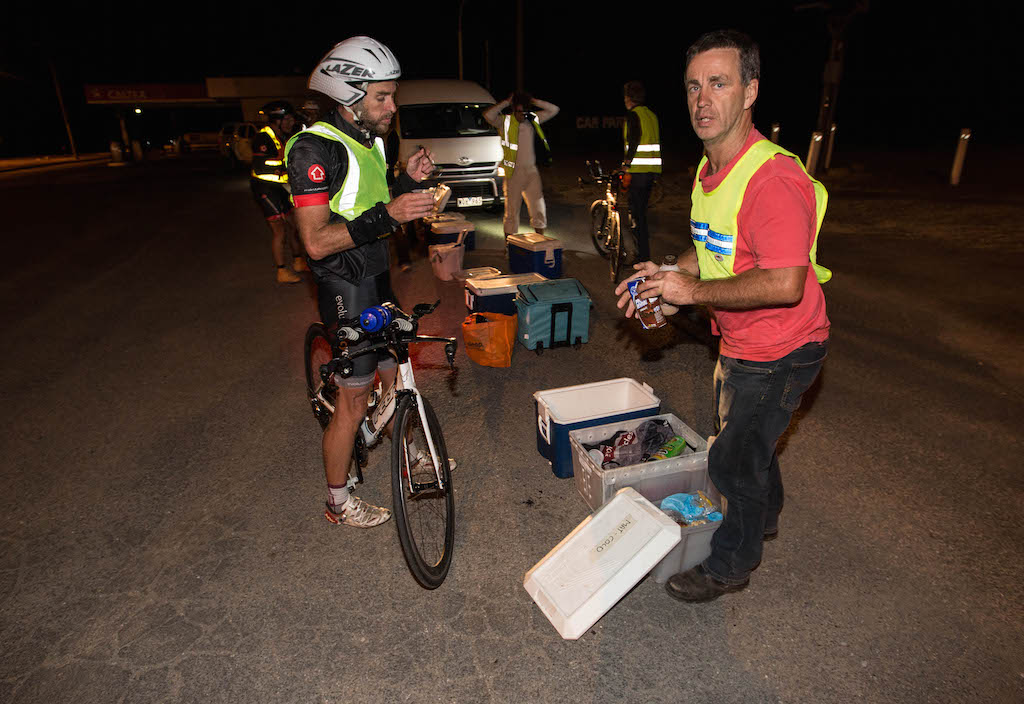
All about the food and coffee with cyclists.
Unfortunately, we had also lost our second rider (Mat Tippett) along the way at around 460km. Mat (a Director and Coach at Elite Triathlon Performance Australia) was so strong in the first 300km doing big turns into the head wind, but later on his struggle with nausea and vomiting meant he couldn’t keep sufficient food or drink down.
Again, like Tom he was there one moment and gone the next. No discussion and no argument – just a selfless decision for the team by Mat which no doubt saved us valuable time.
Had he lingered, we probably would have slowed further in the hope he might recover as we were still ahead of schedule. But Mat’s quick call made it a non-issue. So on we went.
The End
Marty Fluker was also suffering from severe nausea by now, and his feet were also hurting. He had been plunging his feet shoes and all into ice baths at our control points along the way. But, foot pain in an activity dependent upon pedaling is impossible to ignore.
Even though at the 517km mark we were around 17 minutes ahead of schedule, I was growing concerned about our ability to sustain the pace we would need over the remaining 8 hours to break 778km. Marty was struggling, and the forecast was for more cross and head winds on our course east to Kyabram and then south to Mooroopna and Murchison.
We pressed on regardless.
Our next section took us 60km east towards Rochester, which despite the cross winds and an ailing third rider we did this in a 31kph average. But Marty was gone now. Off the back, silent and spent after battling nausea for about 6hrs.
As we rolled slowly through that last 7km towards Rochester, our partners and some friends and some of the kids were assembled to cheer us on. I don’t think they knew we were nearing the end, as by the clock we were still on schedule.
We slowed to greet our supporters. Kisses and hugs. Tears. And at that moment Marty tumbled off his bike into the roadside dirt, utterly exhausted and unable to stand up.
We called it quits at that moment…a few minutes past 2:00am with 584km done. It would have been selfish and unfair on the support crew to press on with two riders for a distance that wouldn’t be officially recognised.
And by then Marty couldn’t stand and could barely speak. Our crew helped him into the van and made him comfortable. He called Chris and I over and started apologising in tears, but we were having none of that. “Its just mates riding bikes Marty, you’ve got nothing to be sorry for. You gave us 110% Its just a bike ride” we said, and hugged him.
An hour or so later he was taken by ambulance to Bendigo hospital with uncontrollable vomiting, an irregular heartbeat, and concerns about renal failure. The Doctor at Bendigo hospital told him his body had basically started eating itself.
Thankfully, Marty recovered quickly and true to character was on the phone the next day from the car back to Melbourne analysing the ride, sounding positive and happy. “Life is good” he said.
Watching what Marty went through for the team was the toughest and most emotional moment of the ride for me. Moments like that really put things into perspective. “Just mates riding bikes”.
It didn’t define the experience completely though.
Postscript
In retrospect, our gathering of supporters at Rochester was a fitting end to Team Pane e Acqua’s 2015 24hr record attempt. It would have been a hollow experience finishing alone on that Rochester corner without family and friends around us.
In the days following the ride people have been asking me if I feel disappointed. Failing to finish is a little disappointing, sure. Lots of effort training, planning, and all the rest of it, and then failing to achieve those numbers we all wanted: five riders going over 770km in 24 hours.
But in the end, on amateur team endurance rides like the Flèche Oppy it’s not about the numbers really. We’re not professional riders whose livelihoods depend on race success. Our chances of a future cycling career is not at stake here. We’re all too old for that!

Team Pane e Acqua: Riders – Mat Tippett, Tom Ainsworth, Craig Fry, Chris Munro, Marty Fluker. Support Crew – James Black, Simon Maddison, Mark Trigger, Jeremy Canny-Smith, Dennis Neal Sponsors – REA Group realestate.com.au and Elite Triathlon Performance Australia
What does count most in these types of challenges is the friends and family around you. What matters is the people who believe in you, get behind you, put themselves out for you – the people who care about you more than the final results.
We had that in spades with:
- A support crew who gave up their weekend, and significant other time and effort to help us in the record attempt.
- Families who did the same, as well as putting up with our regular training efforts, absences, and our anxieties over injury, bad training days, or missed rides.
- Friends who travelled hundreds of kilometers and came out in the cold and dark to cheer for us, and offer a pat on the back and words of support.
For Team Pane e Acqua, even though we all would have dearly loved to get that record, in the end it WAS all about the journey and the fine people around us. Not everything that matters can be counted.
That’s the cycling I know and love.
Craig Fry is a Melbourne-based researcher, writer and amateur cyclist. His cycling articles can be seen here at CyclingTips, at The Conversation and The Age. Follow him on Instagram and Twitter and Strava.
